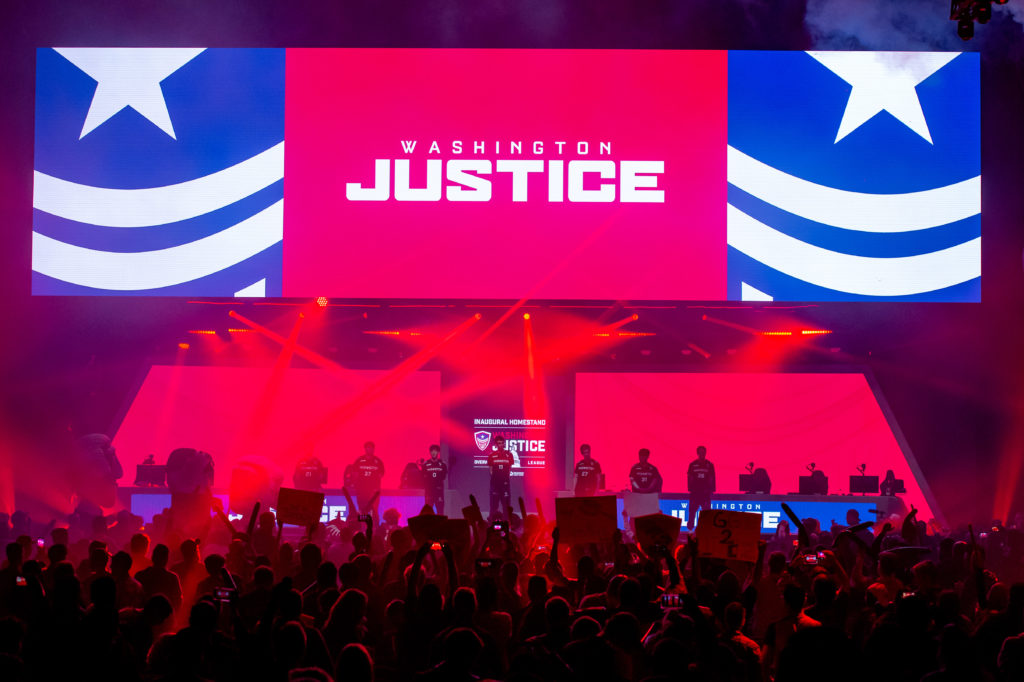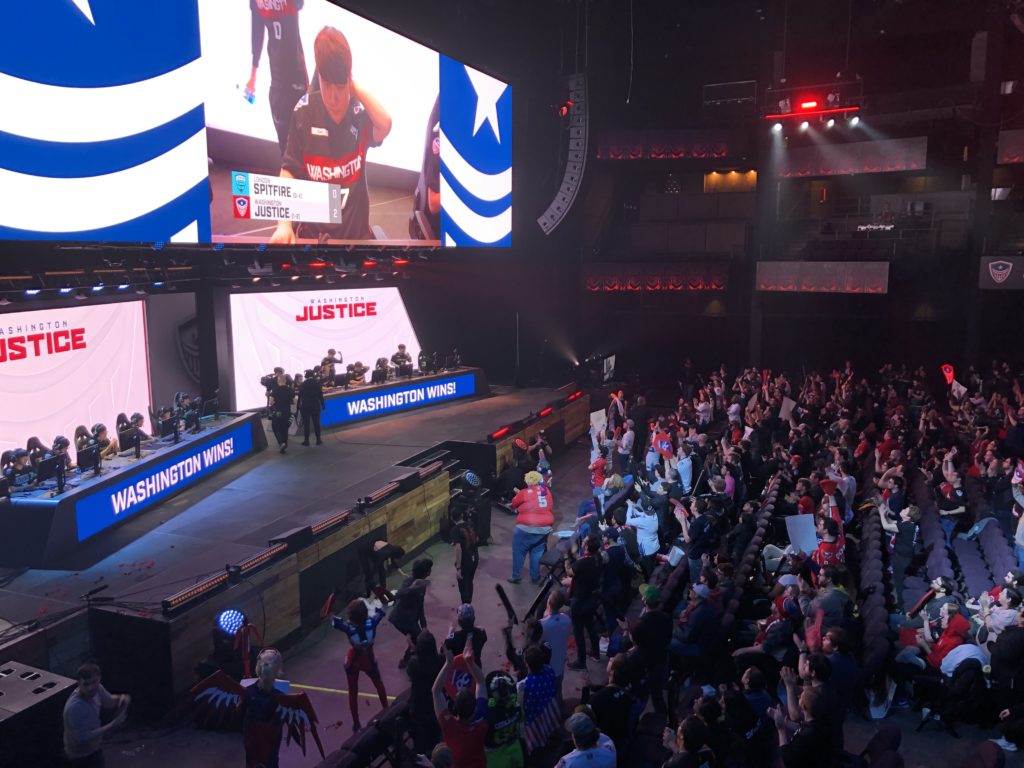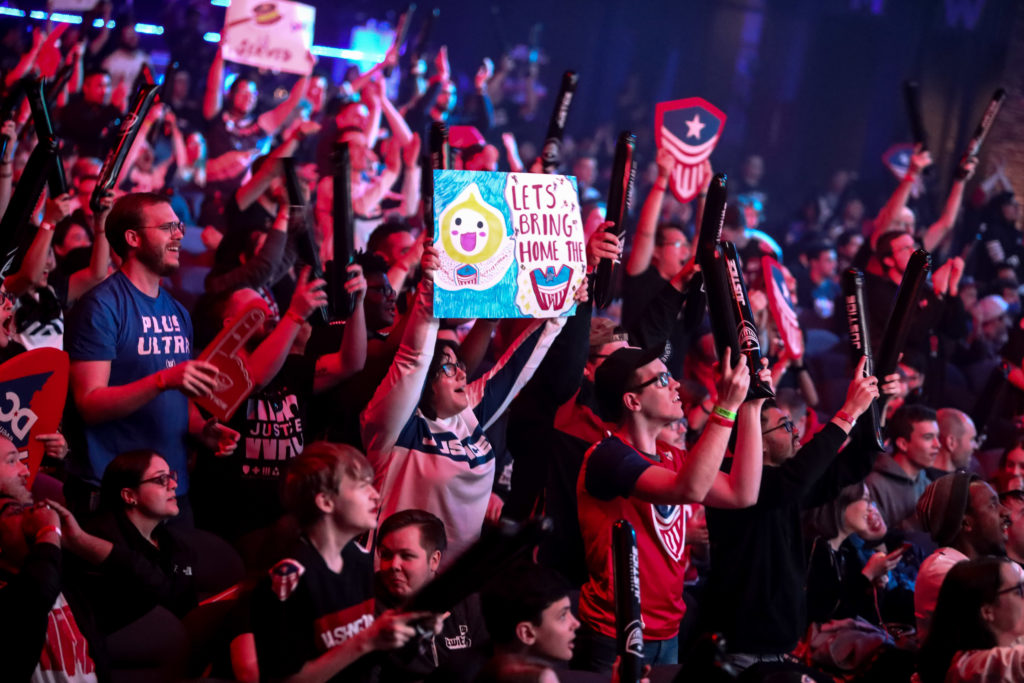By Matthew Koehler

On Feb. 22-23, D.C.’s new professional esports team, the Washington Justice, hosted their first homestand with several other teams from around the world over at The Anthem. Not your traditional sports venue with traditional athletes, though serious hand-eye coordination and a regular workout regimen are part of the game, this was Overwatch League (OWL) – a first-person shooter esports (electronic sports) competition.
In esports, the physical activity is mostly limited to rapid eye movements and some skillfully furious mouse work. Above them on the stage, in stark contrast to the players’ sedentary positions and serene faces, a high-def video screen showed a different story: booming sound effects and a frenzied battle between animated avatars rapidly navigating technicolor maps.
A newbie like me was not prepared for the spectacle, and it was a spectacle, both the competition on-stage and the show off-stage.
“We have a lot of surprises. You’re gonna see amazing action in the game and a lot of cool stuff happening around it,” said owner Mark Ein (owner of the Washington Kastles – a world tennis team) during the media scrum before the matches on Saturday. “I think our walkout is going to be epic and memorable,” he added.
Watching the team walkouts, the London Spitfire received loud boos from the several thousand gathered spectators. A costumed English gentleman came out from behind the stage with a tea tray, which elicited more booing from the crowd. Uncle Sam skipped out after to a roar from the crowd and slapped the tea set out of the English Gentleman’s hands.
The gauntlet was throne.
The lights went out, electronica blasted out of the speakers, smoke billowed out of machines suspended from the ceiling, and the Nationals racing Presidents (a sports collaboration Ein hinted at during the media panel) made their way through the crowd. Acrobats twisted around metal rings suspended 20 feet off the floor in front of the stage and the Justice came out one-by-one to an ever louder audience.
So what was the actual gameplay like? Pure chaos on a giant, high-def screen to be blunt. The insider knowledge bar seemed quite high, and knowing nothing about Overwatch, let alone video games from at least the last 10 years, can be utterly confusing to someone not in the know. I was lost during the first round of play – my past gamer experience hardly helped, but the crowd’s reactions keyed me into the ebb and flow of the game.

The Justice quickly went two rounds to zero and everything stopped. Intermission time.
During the intermission, sort of like halftime, there was more crowd pleasing entertainment. The stage hype man announced a competition on the loudspeaker and assembled spectators for a Coca Cola chugging contest, only to have them belch out responses. A young woman from Baltimore won that burp battle. The day before, someone proposed to his girlfriend (I wasn’t there for that).
It was, indeed, the show that Ein promised. Part of the strategy with this new endeavor is to not just appeal to the hardcore fans, but to draw in the passive fan and the completely uninitiated like myself. The idea is to provide something for everyone, something familiar that fans of other sports can appreciate and will have them coming back for more.
Ein was drawn to Overwatch, as an anchor investment in esports, because he believes the city-based model (cities playing other cities, as opposed to non-local teams playing teams) is the best onramp to esports. “[I]t’s a model that traditional sports fans, not just esports fans, understand. So I can tell people who really are new to esports, do you want to watch Washington kick Paris’ butt tonight? And cheer for them loudly. People get that.”
I asked Assistant GM of the Justice, Aaron Heckman, if he felt that, moving forward, whether or not OWL will be accessible to people who don’t play it at all. Especially considering exactly how to bring in more passive fans in the future. “That’s a really accurate observation and we as an organization, OWL, and Blizzard, in general, need to do a better job of educating people. There is a barrier to entry that we need to get over.”
But in Heckman’s personal experience, he did not feel that barrier was much higher than traditional sports. He pointed out that he was never a pro player himself, not even close, but that’s the same for football or basketball fans. Most people going to watch traditional athletic sports aren’t players themselves (anymore at least), but that doesn’t prevent them from watching and enjoying the sport.
His advice, then, to new fans?
“When I sit people down. The first thing you do is watch the kill feed. They’re going to be jumping perspectives. They’re going to be jumping people, 1st person, 3rd person…but the kill feed will always be there. [I]f your team’s color is on the left, you’re winning. And if your team’s color is on the right, you’re losing.That’s how I explain it to my parents.”
Every once in a while, something big would happen, an all out melee between the teams, an explosion, a magical blizzard, or giant red dragon appearing out of nowhere. All these got the crowd excited, and I knew my home team was advancing their objectives.
After a while of gameplay – matches can last anywhere from 45 minutes to over two hours (they set a record for the longest match on Saturday) – my eyes started focusing on other in-game metrics: the timer, the map number, and even, occasionally, the objectives of various maps. I felt that I was beginning to understand a little of what was going on.
After the intermission, London came back renewed and took two unanswered rounds from the Justice. The match came down to the wire with everyone on the edge of their seats, including me. I found the team’s vice president, Grant Paranjape, dancing around on the upper balcony, exasperated.
Something happened on the screen, there was a lot of noise and the gameplay reached a fever pitch, then it all ended. In big bold letters, all the screens showed “London Wins!” and that was it. Game over, man.
Despite the two losses in their inaugural homestand, the weekend was an overall success for the start of esports in the District. Minseok ‘AimGod’ Kwon, a player for the Justice said afterwards, “It was a really amazing experience. The cheering for us was really loud and really good energy for us.”

The Washington Justice play two more homestands at The Anthem, March 7-8 and April 4-5, then two matches at Entertainment And Sports Arena, May 30-31 and June 20-21.

